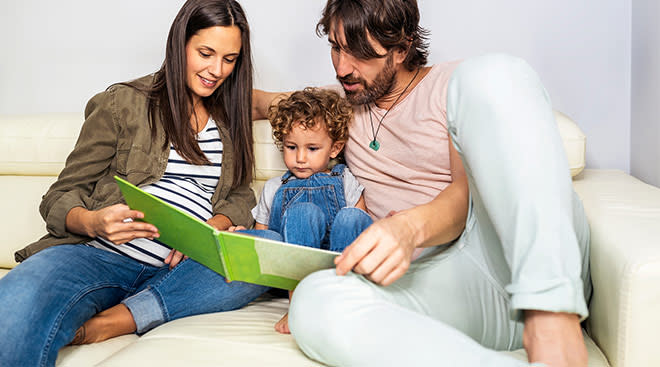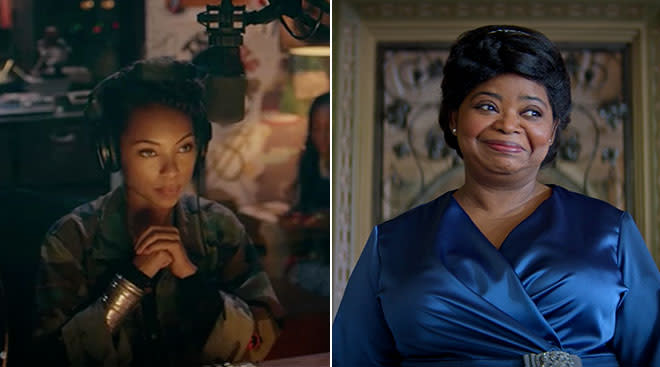How to Teach Toddlers to Share
It’s an all too common scene: two small children playing tug of war with a toy as cries of “mine” get louder and louder. It might end in hitting, biting, crying or some combination—but any which way, it’s not pretty. Learning to share is an important but difficult milestone for any toddler, and one that parents often try to instill from an early age. But what is the importance of this social skill? When are youngsters developmentally able to grasp the concept? And once they’re ready, how can we help kids learn to share? We tapped some parenting experts to weigh in and offer guidance and tips for how to teach your toddler to share.
Let’s face it: No one wants their kid to be the one on play dates who hogs all the toys or screams when another child even looks at something of theirs. But the importance of learning to share goes beyond feeling judged as a parent. “Learning to share, especially as early as possible, sets a social standard of being able to create and sustain interpersonal relationships and develop friendships,” says Kevin Owen, MS, LPC, a clinical psychotherapist and developmental expert in Oklahoma City.
For toddlers, learning to share occurs through play. “Play is considered the universal language of childhood, given that children learn, explore their immediate environments and first begin to communicate through play,” explains Francesca Lormeus, MS, CCC-SLP, TSSLD/BE, a New York-based early intervention provider and licensed speech-language pathologist. “Sharing is a crucial skill for children given that it teaches them about turn-taking, negotiation, collaboration and cooperation skills, which are critical skills that are required for later success in life.”
Besides the external, social benefits, Adam Cole, co-director of Grant Park Academy of the Arts, points out that sharing has intrinsic benefits as well. “You learn to let go, you get pleasure out of giving rather than taking and you have better relationships,” he says.
Learning to share is a process. Babies aren’t born knowing how to share, and toddlers certainly don’t master the skill overnight. “I think the most important thing is for parents to know that it takes practice,” says Roseanne Lesack, PhD, BCBA-D, ABPP, a parenting expert and director of the Unicorn Children’s Foundation Clinic at Nova Southeastern University in Fort Lauderdale, Florida. “When children first learn to walk, they fall down a lot and they get back up and they try again; it’s the same thing with sharing. They’re going to totally mess it up. They’re going to fail, and parents just have to be patient with their child to get back up and try and try again.”
It’s certainly worthwhile to begin instilling values of kindness early, though as Lisa Howe, MSW, a certified Peaceful Parenting coach, points out, children aren’t developmentally equipped to fully understand the concept of sharing until age 3—and not until age 5 or even older to master it. “Children have to understand the concept of equality, which is a higher level concept, to feel safe sharing their belongings or—heaven forbid—their food and know there will still be enough for them,” she says.
So how can you help children grasp the concept? Here, 12 expert tips for teaching kids to share:
1. Understand what it means to share
Before teaching your child to share, it’s important that you as parents have a realistic understanding of what sharing looks like in the real world. “Adults don’t really share. Imagine if someone walked up to you, took your phone and started using it. Or perhaps your car keys. Neither of those things would go over so well, would they?” Howe says. “Yet we expect toddlers to be able to share their precious belongings!” So first decide what you want sharing to look like.
2. Encourage taking turns
These days, the concept of taking turns has gained favor over sharing because it more accurately reflects the real world situations we’re hoping to prepare our kids for. “It helps teach children the back and forth that’s also needed for communication,” explains Lindsey Kiamanesh, MS, CCC-SLP, a pediatric speech language pathologist and founder of OnWords Therapy.
3. Set a timer
To help facilitate turn-taking, a timer may be helpful. “Toddlers may not understand that they’ll get this cherished object back. Using a visual, such as a sand timer or even a timer on your phone, may make this task more manageable,” Kiamanesh says. “It helps children see the passage of time and lets them know when it’s time for them to give up a toy and when it’s time to get their toy back.”
4. Help them wait
Patty Wipfler, founder of Hand in Hand Parenting and author of Listen: Five Simple Tools to Meet Your Everyday Parenting Challenges, recommends an alternate approach: Let a child play with a toy for as long as they want. Rather than focus on getting them to share, she focuses on helping the other child wait their turn. Parents can say something like, “You can have a turn when Sasha is finished with it. I’ll help you wait.” In her experience, when youngsters have a grownup to listen to them and give them space to cry if need be, they often brighten up and move on to something else.
5. Model sharing
“It’s really important to be modeling this behavior on a regular basis,” Lesack advises. She suggests integrating it into regular behaviors throughout the day. For example, if you’re eating an orange, offer your child some. “I think you can always be proactively modeling what you do and how you can intentionally be sharing,” she says.
6. Narrate your actions
Lesack points out that narrating what you’re doing as you model it is key. Own agrees. “A lot of parents are teaching their kids to share, but they’re not explaining what they’re doing while they’re doing it. If you’re sharing with them, explain to them that’s what you’re doing,” he says.
7. Give them time with other kids
Owen also recommends ensuring that your child gets plenty of practice by being around other children. “Kids learn to share with other kids by spending time with other kids and playing. It’s easy to share with adults—what do we care about playing with a stuffed monkey?” he notes. “Put your child in a place where they can practice sharing and being shared with.”
8. Prepare for play dates
Especially as your toddler gets older, you can work to preempt sharing struggles by talking about the expectations for sharing or taking turns with friends. If the play date is in your home, Howe suggests asking your child if there are any particularly special toys they want to put away.
9. Step back
While this may be uncomfortable for parents, sometimes the best thing you can do is step back and let kids try to work it out on their own. “If the negotiations between the children move from verbal to physical, then adult intervention to use this as a teaching moment would be helpful,” says Robert Myers, PhD, a child psychologist and associate clinical professor of psychiatry and human behavior at UC Irvine School of Medicine in Orange, California.
10. Acknowledge when they share
As with anything in life, a little acknowledgement goes a long way. “Provide positive reinforcement, including but not limited to smiling, hand clapping and saying ‘good job’ with excitement when the child attempts to share with others,” Lormeus says. “Positive reinforcement serves as a tremendous motivating factor when teaching children.”
11. Read books about sharing
Myers suggests reading books about sharing for toddlers as a teaching tool. “This is a time to find children’s books that have stories that teach empathy and kindness, such as sharing, and read them to your child,” he says. Some best sharing books for toddlers include Llama Llama Time to Share, The Big Umbrella and It’s Mine!.
12. Play sharing games
Sharing games for toddlers offer a fun way to model turn-taking. Almost any game fits the bill—even peek-a-boo provides opportunities for cooperative play. For young toddlers, a game like ThinkFun’s Roll & Play is an excellent introduction to taking turns without any winning or losing. Sneaky Snacky Squirrel and Shoots and Ladders are both great early board games that teach taking turns as well.
It will take some time, but your child will learn to share. It’ll take practice, some failed attempts and a lot of encouragement and modeling, but they’ll get there.
Please note: The Bump and the materials and information it contains are not intended to, and do not constitute, medical or other health advice or diagnosis and should not be used as such. You should always consult with a qualified physician or health professional about your specific circumstances.
Plus, more from The Bump:
Adam Cole is a musician and the co-director of Grant Park Academy of the Arts. He holds a master’s degree in music from Georgia State University.
Lisa Howe, MSW, is a certified Peaceful Parenting coach. She earned her master of social work degree from San Diego State University.
Lindsey Kiamanesh, MS, CCC-SLP, is a pediatric speech language pathologist and founder of OnWords Therapy. She earned her master’s degree in communicative disorders from California State University, Northridge.
Roseanne Lesack, PhD, BCBA-D, ABPP, is a parenting expert and director of the Unicorn Children’s Foundation Clinic at Nova Southeastern University in Fort Lauderdale, Florida.
Francesca Lormeus, MS, CCC-SLP, TSSLD/BE, is a New York-based early intervention provider and licensed speech-language pathologist. She earned her master’s degree in speech-language pathology from Columbia University.
Robert Myers, PhD, is a child psychologist and associate clinical professor of psychiatry and human behavior at UC Irvine School of Medicine in Orange, California. He earned his doctorate in counseling psychology from the University of Southern California.
Kevin Owen, MS, LPC, is a clinical psychotherapist and developmental expert in Oklahoma City. He holds a master’s degree in counseling psychology from Mid-America Christian University and a doctorate in clinical counseling from Midwestern Baptist Theological Seminary.
Patty Wipfler, is the founder of Hand in Hand Parenting and author of *[Listen: Five Simple Tools to Meet Your Everyday Parenting Challenges(https://www.amazon.com/Listen-Simple-Everyday-Parenting-Challenges/dp/0997459301?&linkCode=ll1&tag=tb-how-do-i-teach-my-toddler-to-share-toys-20&linkId=0c6be1b51d79575b078ef3c06d3b1d51&language=enUS&ref=as_li_ss_tl).*.*)
Learn how we ensure the accuracy of our content through our editorial and medical review process.
Navigate forward to interact with the calendar and select a date. Press the question mark key to get the keyboard shortcuts for changing dates.




















































